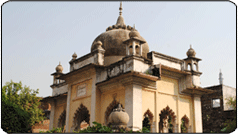Maqbara of Mir Anis
Mir Anis is famous for his Rubaiyat (four lined poetic compositions i.e. quatrain) which have also been translated into English. Yet, it is Marsia (elegy or threnody) and Mir Anis that are synonymous and inseparable in Urdu literature.
In marsia, the lyrical narration of the story of martyrdom of Imam Hussain at Karbala, Mir Anis highlighted human values and virtues strengthening the moral fibre of mankind. He interposed Indian practices and customs of social life in his poetry thus making the marsia, a very popular idiom. We find many non-Muslim poets who have composition of marsia to their credit because of its popularity, particularly for recitation in majlis, during the mourning period of Muharrum.
Mir Anis belonged to a family of poets of Delhi who had migrated to Faizabad, which was then the capital of Awadh. His grandfather Mir Hasan was a famous poet, celebrated for his lyrical composition of a Masnavi titled Sahar~ul-Bayan. His father Mir Khaieeq, who restricted himself to the composition of marsia was also acclaimed for his work.
Originally named Babbar Ali, Anis was born in Faizabad in 1801 (some consider him to be born as early as 1796-97). With the family's trait of prosody in his blood, Anis is said to have composed his first couplet around the age of six which was about his favourite goat that had died. He composed a marsia for the benefit of the ladies of his household at the age of fourteen years. His takhallus (pen name) was Hazeen and he also composed ghazal. On learning of his son's romantic poetry, Mir Khaieeq advised him to follow him and restrict himself to the composition of marsia which being a service to their faith was considered to be more noble. Babbar Ali heeded the advice and gave up the composition of sheyr (couplets) for ghazal. Mir Khaieeq often came to Lucknow when it became the capital of Awadh to recite marsia. Mir Anis accompanied his father on these visits. Appreciative of the composition of a marsia by Babbar Ali recited in his presence, Ustad Nasiq, a celebrated poet attached to the Court, suggested that the budding poet change his pseudonym from Hazeen to Anis. Thereafter, with Nasiq's blessing, it was laurels all the way for Anis as a marsia-go (composer of marsia).
Mir Anis shifted along with his father to Lucknow in 1842. The family initially settled down at Shaidon ka Ahata (which is covered today by the railway line between Lucknow City station and the railway bridge over river Gomti). Anis built an Imambara over the grave of his father, Mir Khaieeq, near his residence when he died in 1844. The residence and imambara were demolished when the conflict of 1857 began, when nearly two thirds of the Nawabi buildings were blown off by the British.
It was only when the last King of Awadh, Wajid Ali Shah was deposed [and left for Calcutta] that Mir Anis accepted royal patronage and offers from other states to go beyond the limits of Lucknow to recite his marsia. He went to Hyderabad and ether cities where he was lauded, yet, he missed the appreciative audience of Lucknow.
In his later compositions one can feel the agony of the tragic events that followed the rebellion against the British rule. The poet himself had fled to Kakori a nearby qasba (town) fearing harassment for being close to the deposed King. On his return to Lucknow, he shifted to a house in Chowk where he died on December 10, 1874. The locality (koocha) in Chowk, having his house and the nearby maqbara [built over the tomb of Mir Anis, on his birth centenary around 1991-92] is named as Koocha Mir Anis, in honour of the poet.
Source:
Hindustan Times, City Scan, A Time in History
Wednesday 19.5.1999 — A requiem to a poet

